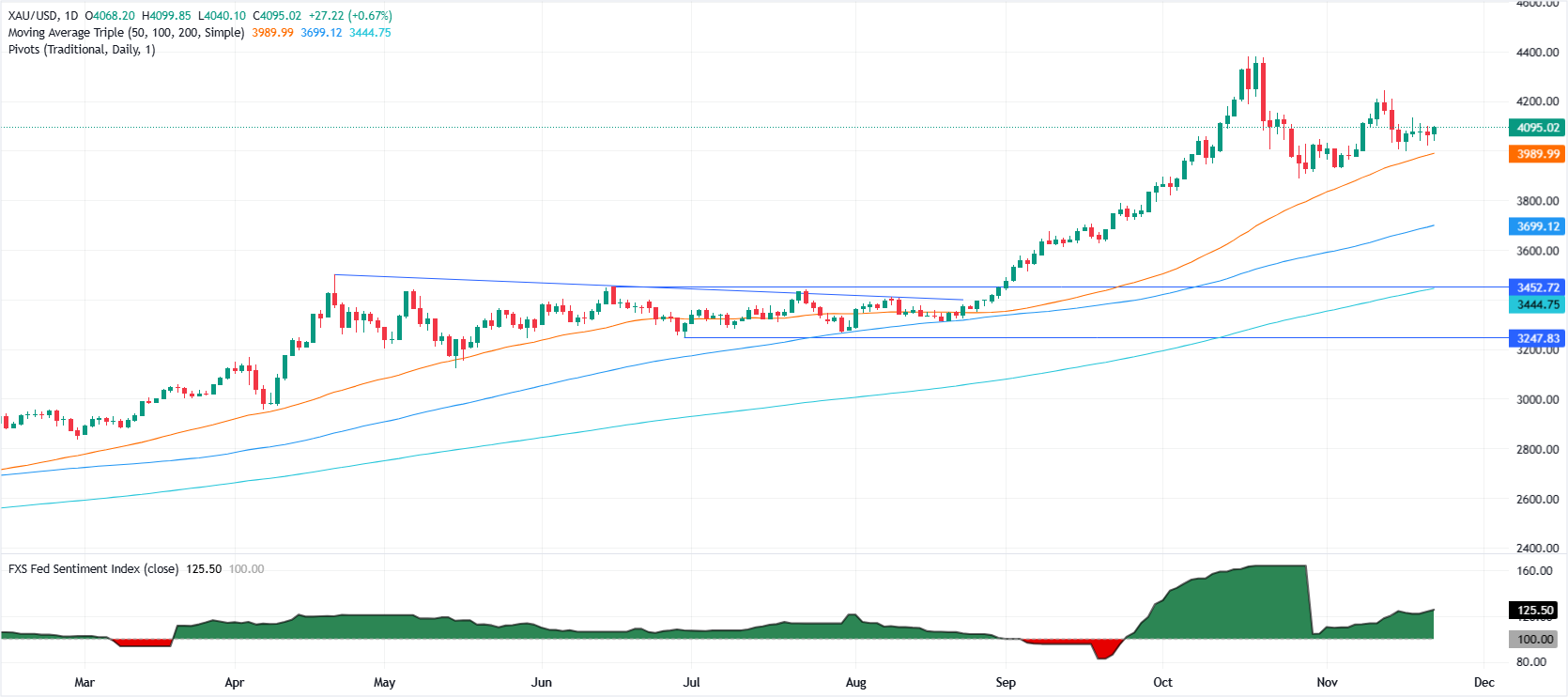Gold surges toward $4,100 as markets go all-in on Fed cuts
- Gold rises 0.80% toward key resistance as markets grow confident the Fed will cut rates next month.
- Dovish Waller and Williams' remarks push December cut odds to 76% despite a firm US Dollar.
- US data-heavy week ahead before the Fed enters blackout period.
Gold (XAU/USD) rallies sharply on Monday, gaining 0.80% as investors seem confident that the Federal Reserve (Fed) will slash rates at the December meeting as US economic data continues to flow. At the time of writing, XAU/USD trades near $4,100 after hitting a daily low of $4,040.
XAU/USD climbs for a fourth day inside its tight range on falling Treasury yields
The non-yielding metal resumed its advance, yet it remains confined to the $4,040-$4,100 range for the fourth consecutive trading day. Dovish comments by Federal Reserve officials increased the likelihood of a 25-basis-point (bps) rate cut at the December meeting.
Fed Governor Christopher Waller supports a December cut, echoing last Friday’s comments by the New York Fed President John Williams, who said that a December cut is possible, due to a weakened labor market.
Although the Greenback remains solid, the yellow metal performs well, propelled by the fall of US Treasury yields due to speculation of a low-interest-rate environment.
Consequently, market participants see a 76% chance of a December rate cut, a sharp jump from 42% a week ago, according to the FedWatch Tool.
Ahead this week, the US economic docket will feature the ADP Employment Change 4-week average, the Producer Price Index, and Retail Sales on Tuesday. By Wednesday, Durable Goods Orders and Initial Jobless Claims could set the stage ahead of Fed officials entering their blackout period.
Daily market movers: Dovish comments drive Bullion’s price higher
- Federal Reserve Governor Christopher Waller expressed support for a rate cut in December but said a move in January is less certain. In an interview with Fox Business, Waller noted that “most of the private sector and anecdotal data we've gotten is that nothing has really changed. The labor market is soft — it’s continuing to weaken.”
- Gold prices so far have ignored advances in the geopolitical front as the US and Ukraine work on a plan to end the war with Russia. The 28th point plan drafted by the White House and the Kremlin is seen as favorable to the latter.
- Last Friday, NY Fed John Williams said they can still cut rates in the “near-term”, which boosted odds for a December move.
- The US Dollar Index (DXY). which tracks the buck’s performance versus six currencies, registers modest gains of 0.05% at 100.26. At the same time, US Treasury yields fall, with the 10-year US Treasury note yield falling two and a half basis points to 4.042%. US real yields, which correlate inversely to Gold prices, are falling nearly two basis points to 1.827%.
Gold technical outlook: Poised to clear $4,100
Gold trades sideways as investors wait for the next catalyst. Technical indicators like the 20- and 50-day Simple Moving Averages (SMAs) are flat, with the 20-day SMA being the first support at $4,045. The Relative Strength Index (RSI) is bullish; hence, the path of least resistance is upwards.
XAU/USD first resistance would be $4,100, followed by $4,150 and by the last cycle high of $4,245, November’s 13 peak. On the flipside, Gold’s first support is the 20-day SMA, followed by the November 18 swing low of $3,998, ahead of testing the 50-day Simple Moving Average (SMA) at $3,989.

Gold FAQs
Gold has played a key role in human’s history as it has been widely used as a store of value and medium of exchange. Currently, apart from its shine and usage for jewelry, the precious metal is widely seen as a safe-haven asset, meaning that it is considered a good investment during turbulent times. Gold is also widely seen as a hedge against inflation and against depreciating currencies as it doesn’t rely on any specific issuer or government.
Central banks are the biggest Gold holders. In their aim to support their currencies in turbulent times, central banks tend to diversify their reserves and buy Gold to improve the perceived strength of the economy and the currency. High Gold reserves can be a source of trust for a country’s solvency. Central banks added 1,136 tonnes of Gold worth around $70 billion to their reserves in 2022, according to data from the World Gold Council. This is the highest yearly purchase since records began. Central banks from emerging economies such as China, India and Turkey are quickly increasing their Gold reserves.
Gold has an inverse correlation with the US Dollar and US Treasuries, which are both major reserve and safe-haven assets. When the Dollar depreciates, Gold tends to rise, enabling investors and central banks to diversify their assets in turbulent times. Gold is also inversely correlated with risk assets. A rally in the stock market tends to weaken Gold price, while sell-offs in riskier markets tend to favor the precious metal.
The price can move due to a wide range of factors. Geopolitical instability or fears of a deep recession can quickly make Gold price escalate due to its safe-haven status. As a yield-less asset, Gold tends to rise with lower interest rates, while higher cost of money usually weighs down on the yellow metal. Still, most moves depend on how the US Dollar (USD) behaves as the asset is priced in dollars (XAU/USD). A strong Dollar tends to keep the price of Gold controlled, whereas a weaker Dollar is likely to push Gold prices up.

